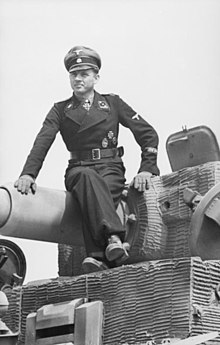Zimmerit
This article needs additional citations for verification. (July 2009) |



Zimmerit was a coating produced for German armored fighting vehicles during World War II for the purpose of combating magnetically attached anti-tank mines, although Germany was the only country to use magnetic mines against tanks in large scale numbers. It was created by the German company Chemische Werke Zimmer AG.[1]
Operation
The coating was a barrier that prevented the direct contact of magnetic mines against the metal surfaces of the vehicle. It was normally ridged to increase the overall thickness. This spacing reduces magnetic attraction, and causes magnetic mines to fall off from their own weight and the vibration of the vehicle. Zimmerit possessed no anti-magnetic properties of its own, rather it defeated the mines by disallowing contact and providing distance.[1][2]
Deployment
Zimmerit was applied to some tanks and closed-top self-propelled guns produced from December 1943 to 9 September 1944.[2] It was only rarely applied to open-top AFVs. The rough appearance of the coating gave a distinct appearance to the vehicles it coated.
Application of Zimmerit was usually done at the factory. The many variations seen in application designs, from the regular ridge-shaped pattern, to a less common waffle-shaped pattern, are mostly related to the factory producing each type of AFV. For example, the waffle pattern was seen almost exclusively on Sturmgeschütz III assault guns. In general, vehicles already in service were not given coats of Zimmerit.
Zimmerit was discontinued from factory application on 9 September 1944 and from field application on 7 October 1944.[3] This was due to concerns that projectile impacts could set it on fire. These proved false, but the order was never rescinded.[2][3] Applying and drying the paste added days to the production of each vehicle,[1] which was unacceptable as there was a shortage of tanks.
Following the war, the British carried out trials of a similar material on Churchill tanks but decided not to implement it. No similar material was used on post-war tanks, probably because the widespread use of man-portable HEAT rockets such as the Bazooka made magnetic mines obsolete.
Ingredients
The paste was composed of the following:[1][2]
- 40 % Barium sulfate - BaSO4
- 25 % polyvinyl acetate – PVA (similar to wood glue)
- 15 % pigment (ochre)
- 10 % Zinc sulfide – ZnS
- 10 % sawdust
Vehicles with factory-applied Zimmerit
Notes
References
- Jentz, Thomas; Doyle, Hilary (1993), Kingtiger Heavy Tank, 1942-45, London: Osprey, ISBN 1-85532-282-X
{{citation}}: Invalid|ref=harv(help) - Rottman, Gordon (2005), World War II Infantry Anti-Tank Tactics, City: Osprey Publishing (UK), ISBN 9781841768427
{{citation}}: Invalid|ref=harv(help) - Spalding, Donald, "ZIMMERIT: Production and Application Methods", Afv News (Jan–Apr/1983), archived from the original on 2007-10-05
{{citation}}: Invalid|ref=harv(help)
External links
- "The history of Zimmerit", panzerworld.net, retrieved 12 December 2009
